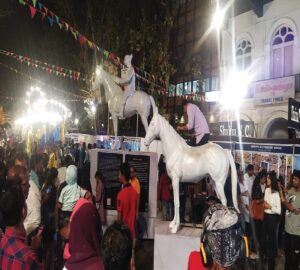 The nine-day Kala Ghoda Arts Festival in is an exhibition and celebration of art in many forms
The nine-day Kala Ghoda Arts Festival in is an exhibition and celebration of art in many forms
The two-year-COVID-induced hiatus that had Mumbai reeling couldn’t keep the city or its people down for long. Swift to bounce back, India’s financial capital has flexed its cultural muscle and how!
Life in Mumbai has become vibrant and its buoyance underlined with back-to-back festivals – of Art, Music, Literature, Sports, Theatre, Comedy and You-Name-It. Mumbai is now the official Festival City Of India with events happening throughout the year.
The Kala Ghoda draw
The Kala Ghoda Arts Festival (KGAF), one of the most popular art festivals in Mumbai — an annual nine-day festival that takes place in February in South Mumbai, arrived in 2023 to mark the 24th edition and featured a range of events such as music performances, dance shows, art exhibitions, street performances, workshops and heritage walks.
Without a doubt one of the most awaited festivals each year, KGAF is an exhibition and celebration of art in many forms. The festival attracts over 1,50,000 people from the city and beyond. It takes place within the historic Kala Ghoda Art District and is open to all, free of charge. The boundaries of the district spread from Regal Circle at the Southern end to Mumbai University in the northern end and Oval Maidan in the west to Lion Gate in the east.
Blessed with rich architecture and heritage, the art district is home to a blend of Indo-Saracenic, Neo-Gothic and Neo-Classical-styled buildings. The prominent structures include architectural marvels like Mumbai University (erstwhile Bombay University), Chhatrapati Shivaji Maharaj Vastu Sangrahalaya – CSMVS (erstwhile Prince of Wales Museum), Elphinstone College, David Sassoon Library, Jehangir Art Gallery and the old Army and Navy Building.
Different sections of the Kala Ghoda Art Festival are held at venues spread across the district in Mumbai – the lawns at CSMVS, Cross Maidan at MG Road, Horniman Circle Garden, Bombay Natural History Society (BNHS), National Gallery of Modern Art, etc.
The highlights this year included 14 Verticals – Dance (Kathak, Odissi, Folk Dances), Music, Visual Arts, Theatre,
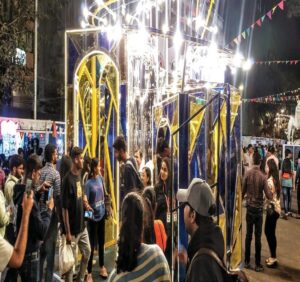 Mumbaikars at the much awaited Kala Ghoda Festival
Mumbaikars at the much awaited Kala Ghoda Festival
Literature, Food, Children’s Literature & Workshops (Puppet and Storytelling, Origami, Astro-Voyage), Cinema, Heritage Walks, Stand-Up Comedy, Street Art, Urban Design & Architecture; and Visual Arts (The Intellectual Crow, Crypto Automobile, #beyourownhashtag).
Mumbai’s filmy obsession
The 17th edition of Mumbai International Film Festival for Documentary, Short Fiction and Animation films (MIFF 2022) was held from 29 May to 4 June 2022 at the Films Division Complex at Peddar Road in Mumbai. Apart from competition and non-competition sections, interactive sessions like workshops, master classes and open forum and B2B sessions were the major highlights of the event.
While feature films generally address the entertainment needs of people, documentaries fill up the information needs of people. In a bid to make MIFF a people’s festival, the delegate fee was kept at a modest Rs 300 while there was no fee for students. The screenings were held in the theatres in Films Division complex in Mumbai.
And then, there’s the Jio MAMI Mumbai Film Festival to be held from 27 October to 5 November 2023 organised by the Mumbai Academy of Moving Image (MAMI) aiming to present the best of cinema and foster a larger ecosystem for cinematic voices in South Asia. Every year, handpicked films from across genres are screened at the festival, where each film is carefully selected based on artistic merit, cultural diversity and relevance to contemporary issues.
Using immaculate programming, the festival showcases creative expressions that re-evaluate cinematic conventions and investigate non-narrative forms, including those that are under-represented in mainstream cinema. It’s a place for emerging and established cinema talent to showcase their work and network with the best from around the world.
Through a variety of discussions, workshops and expert panels, Jio MAMI Mumbai Film Festival encourages critical thinking and dialogue with its audience. In addition to bringing the best of cinema from around the world, the festival also conducts a robust year-round programme that acts as a hub for creators, facilitating the exchange of ideas, providing access to
labs for skill development and exploring business opportunities in filmmaking.
Love for literature
After a two-year gap imposed by the pandemic, The Mumbai Litfest returned with a 13th edition held from 11 November – 13 November 2022, at its customary location at the National Centre for the Performing Arts (NCPA) at Nariman Point in Mumbai.
Due to the pandemic, the editions in 2020 and 2021 were held virtually. And, it were the 8.5 million views from the highly successful virtual Litfest edition in 2021 that raised the bar of online audiences’ expectations.
Among other events that have become synonymous with
Mumbai is the Mumbai Marathon 2023 that returned after two years and witnessed tremendous participation. A whopping 50,000-plus participants joined in the Mumbai Marathon — the largest in Asia — at Bandra-Worli Sea Link, in Mumbai on Sunday, 15 January 2023.
For the event, not less than 3,600 police personnel were deployed to ensure the smooth passage of the Mumbai marathoners. It was the first time the event took place after a break of two years due to COVID-19 restrictions. Senior citizens too turned up to participate in large numbers which raised the spirits of the young participants.
 Rajabai Tower illuminated for the Mumbai Light Festival
Rajabai Tower illuminated for the Mumbai Light Festival
Ek Bharat Shreshtha Bharat
The Union Ministry of Culture’s Rashtriya Sanskriti Mahotsav 2023 was held in Mumbai from 11th till 19th February 2023 at Azad Maidan. The festival, inaugurated by the-then Governor of Maharashtra Bhagat Singh Koshyari, aims to promote National Unity and integrity through cultural exchange.
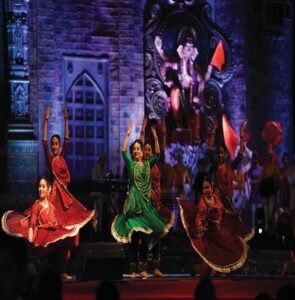 A Kathak dance performance at the cultural festival – Rashtriya Sanskriti Mahotsav 2023
A Kathak dance performance at the cultural festival – Rashtriya Sanskriti Mahotsav 2023
The Mahotsav is organised by the Ministry every year in different states of India and a large number of esteemed artists and spectators gather for the same. In 2019, it was held in Madhya Pradesh and in 2022, in Telangana.
In 2023, for the first time, the cultural festival was hosted in Mumbai. It presented an opportunity to Mumbaikars to experience India’s rich and diverse art, culture, craft and cuisine; to immerse in the vibrant world of Indian culture and gain a deeper understanding and appreciation of the rich heritage.
The initiative is part of the special efforts undertaken by the government to ensure India’s rich culture is passed on to the next generation and there is admiration and awareness about indigenous art and culture.
Rashtriya Sanskriti Mahotsav is envisioned to become a world-famous event like the Kumbh Mela, symbolising Ek Bharat Shreshtha Bharat – despite the numerous diversities in language and cultural expressions, India stays united.
From local to global
The grand Mahotsav hosted more than a thousand artists from across India. These included 150 craftsmen from the seven Zonal Cultural Centres of the Ministry of Culture who showcased
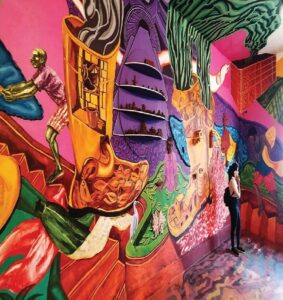 Mumbai Urban Art Festival – Sassoon Docks
Mumbai Urban Art Festival – Sassoon Docks
their respective state’s art and craft. An exhibition space, called ‘Angan’, housed 70 stalls with exhibition-cum-sale of wares from different states and 25 stalls of Maharashtra State Handloom Department.
Besides the art and handicrafts exhibitions, there were performances of tribal and folk dancers, classical artists, entertainers, martial art practitioners, etc. Captivating performances from 350 folk and tribal artists and 300 local folk artists, in vibrant costumes, were the highlights of the festival. The festival featured a variety of folk dances, Lavani, Kathak, Bharatnatyam, etc.
The Mahotsav was packed with exciting performances by renowned Indian artists such as Mame Khan, Rahul Deshpande, Maitreyee Pahari, Nitin Mukesh, Avinash Chandrachud and more.
At the inauguration ceremony, a Kathak dance performance by Tejaswini Sathe and her troupe and a musical show by Mohit Chauhan – who presented a melodious rendition titled ‘Tumse Hi, 25 Saal Ka Surila Safar’ that means ‘A musical journey of 25 years’ – captivated the audience.
Scintillating performances
The cultural festival featured some of the most accomplished Bharatnatyam dancers in the country. A Bharatnatyam performance by Chennai’s Kalakshetra Foundation was the highlight of the festival. Renowned musician and composer Saleel Kulkarni performed at the festival as well. Devotional Marathi artist Anand Bhate presented his special Marathi Abhanga – a unique blend of classical and devotional music.
The evenings at the festival lined up performances by artists across India showcasing classical, folk and contemporary art forms. The Nagaland Conservatory of Music Choir conducted by Lipokmar Tzudir performed a series of mesmerising western and folk music.
Then there was a musical tribute to legendary composer R. D. Burman. It was performed by Raj Sodha, Kishor Sodha and Siddharth Entertainers. There were a host of classical Indian and Bollywood music performances that kept the crowds entertained.
Journey of faith
As part of the nine-day Rashtriya Sanskriti Mahotsav at Azad Maidan in Mumbai, the Indira Gandhi National Centre for the Arts (IGNCA) organised an Exhibition on ‘Pandharpur Vari: A Confluence of Faith and Affection’. It’s an effort to showcase the faith of the Varkaris for their Mauli, as seen during Pandharpur Ashadhi Vari.
One of the biggest pilgrimage sites in Maharashtra, Pandharpur is located on the banks of Chandrabhaga River in Solapur District of Maharashtra. The famous Vithoba / Vitthal temple attracts about a million pilgrims during the annual yatra (procession) in the Hindu calendar month of Ashadh (June – July) known as Vari. It is a more than 800 years old tradition. Lord Vitthal is regarded as affectionate Mauli (Mother) by his followers who are known as Varkaris. Varkari in Marathi means one who performs the Vari or one who venerates Vithoba.
Art and more
The Mumbai Urban Art Festival (MUAF), organised by St+art India Foundation, returned to the city. The three-month long festival commenced on 21 December and concluded on 22 February 2023.
As part of the art festival, landmark murals, experiential exhibitions, immersive installations, etc., were seen at key venues across the city – Mahim East, Bandra, Churchgate Station and Sassoon Docks in Colaba. The idea was to make art accessible to diverse audiences while contributing to urban regeneration and the cultural landscape at large.
MUAF attempts to engage with Mumbai through a long-standing effort of contributing to the contemporary public art heritage. The festival brings together artists and diverse art practitioners to create interdisciplinary properties – to offer opportunities of rediscovering lesser-known paths and forgotten narratives.
At Sassoon Docks, one of the oldest docks in Mumbai, MUAF presented the Sassoon Dock Art Project. After a successful run in 2017, the art project returned to the docks, in collaboration with Mumbai Port Authority, this time on the special occasion of its 150th anniversary.
The art project showcased permanent outdoor murals at the docks and three indoor experiential exhibitions. Large-scale site-specific installations, new media and light based works immersed the viewers in reflections between the sea and the city. As part of the initiative, a host of workshops, talks, art walks, performances, concerts, dance events, children activities, etc., were held at Sassoon Docks.
This year, participating Indian and foreign artists included Aashti Miller, Aarti Sunder, Ad Minoliti, Daku, Dennis Fabian Peter, Durga Shakti Gawde, Luzinterruptus, Sohrab Hura, Steve Messam, Sumit Roy, Tarini Sethi,Trespassers, Vayeda Brothers, and many more.
Across the city
The first part of Sassoon Dock Art Project was Intuitions. Between the sea and the city and the exhibition aimed to pose questions about our complex relationship with the environment, more specifically with water and the expanding hypercity. The second part, Illusions. Between the sea and the city reflected on some of the complexities of the transactional reality, by proposing alternative, fluid and expansive views.
In Mahim (E) Art District, lying between Mahim Station and Dharavi, features 20 murals by local and international artists, since 2014. This year, three large-scale murals, urban tactical interventions such as edible gardens, multipurpose seating, sport courts, etc., were added. The Bandra Project of the MUAF, two temporary installations, a permanent artwork over the popular Carter Road Skatepark and a tailored walk & talk were held.
Promoting local talent
In a one of its kind initiative, this year at the Sassoon Docks Art Project of the Mumbai Urban Art Festival, a community event was held at Sassoon Docks to celebrate the vibrant communities of the docks and to bring the residents
of the zone together for the festival.
Sassoon Docks is a melting pot of cultures with people from all parts of the country, including Karnataka, Uttar Pradesh, Maharashtra, etc., performing specific roles at the docks and operating with clockwork precision.
The event provided an opportunity for locals to showcase their culture and talent, who went on participate with great enthusiasm and fervour. Hundreds of people from diverse communities residing in residential pockets thronged the venue to encourage the participants.
Local participants showcased their talent through performances that included ethnic dances representing Banjara, Koli and Maharashtrian cultures, singing, Hip-Hop, Martial Arts and more.

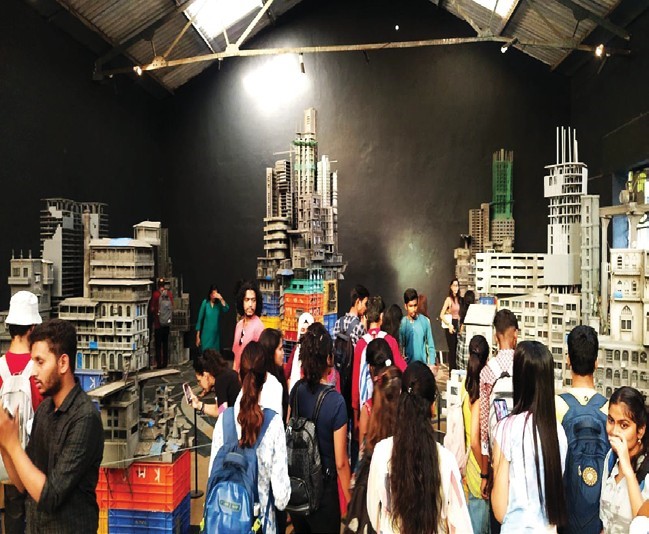
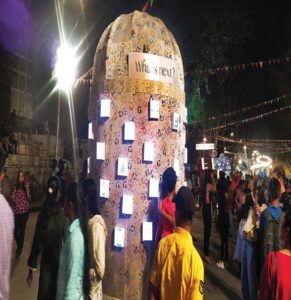
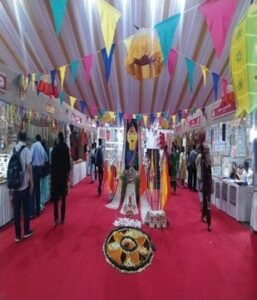
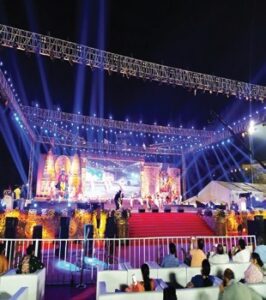
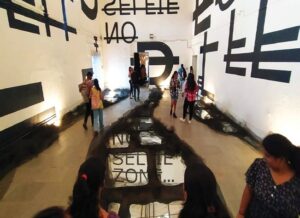
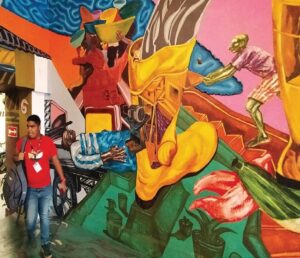
 Manu Shrivastava is a journalist and lawyer with DraftCraft International and Co-Convenor of #TheWomanSurvivor, #MeTooAtHome and #MeTooBeyondBorders initiatives.
Manu Shrivastava is a journalist and lawyer with DraftCraft International and Co-Convenor of #TheWomanSurvivor, #MeTooAtHome and #MeTooBeyondBorders initiatives.